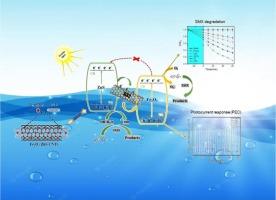Z 型 Fe2O3/ZnS/CNTs 纳米杂化物在可见光下具有更强的光催化性能,可消除磺胺甲噁唑
IF 6.3
2区 工程技术
Q1 ENGINEERING, CHEMICAL
引用次数: 0
摘要
形成复合材料是提高光催化活性的有效方法。本文通过简便的水热法成功合成了新型 Z 型 Fe2O3/ZnS/CNTs 纳米杂化光催化剂(FZC),显著提高了可见光下磺胺甲噁唑(SMX)的光催化效率。这种纳米杂化光催化剂的光降解能力达到 95.1%,是原始 Fe2O3 样品的 3.9 倍。尤其是 FZC 纳米杂化光催化剂的光降解效率常数(kapp)高达 0.025 min-1,分别是原始 Fe2O3 和 ZnS 样品的 12.5 倍和 6.2 倍。而且,FZC 纳米杂化物具有优异的稳定性,其光降解率在五个周期后仍能保持近 90%。Z 型异质结以及在 Fe2O3/ZnS 表面添加 CNTs 所产生的强烈界面耦合效应是提高光催化效率的主要原因。研究还表明,电子供体的结合主要提高了光降解性能,而 CNT 的加入改变了光催化速率,这意味着光降解效率降低,而 SMX 的去除率大大提高。根据分析结果,提出了 Z 型异质结的光降解机理,并深入讨论了该过程中的电荷载流子转移模式。本文章由计算机程序翻译,如有差异,请以英文原文为准。

Z-scheme Fe2O3/ZnS/CNTs nanohybrids with enhanced photocatalytic performance for sulfamethoxazole elimination under visible light illumination
The formation of composite is an efficient method to improve the performance of photocatalytic activity. Herein, the novel Z-scheme Fe2O3/ZnS/CNTs (FZC) nanohybrid photocatalyst was successfully synthesized via a facile hydrothermal process, establishing significantly improved efficiency of sulfamethoxazole (SMX) with visible light activity. This nanohybrid photocatalyst achieves a photodegradation capability of 95.1 %, which is 3.9 folds higher than that of the pristine Fe2O3 sample. Especially, the photodegradation efficiency constant (kapp) of the FZC nanohybrid is as high as 0.025 min−1, which is 12.5 and 6.2 folds higher than that of pristine Fe2O3 and ZnS samples, respectively. Then, the FZC nanohybrid has superior stability and its photodegradation rate can still keep nearly 90 % after five cycles. The Z-scheme heterojunction and the vigorous interfacial coupling effect created by adding CNTs on the surface of Fe2O3/ZnS are the primary reasons for improved photocatalytic efficiency. It was also exhibited that the combining of electron donors mainly enhanced the photodegradation performance, whereas the addition of CNTs changed the photocatalytic rate, which implied a reduced photodegradation efficiency and a great enhancement in SMX removal. According to the analysis results, the photodegradation mechanism of the Z-scheme heterojunction was proposed, and the charge carrier transfer mode in the process was discussed in depth.
求助全文
通过发布文献求助,成功后即可免费获取论文全文。
去求助
来源期刊

Journal of water process engineering
Biochemistry, Genetics and Molecular Biology-Biotechnology
CiteScore
10.70
自引率
8.60%
发文量
846
审稿时长
24 days
期刊介绍:
The Journal of Water Process Engineering aims to publish refereed, high-quality research papers with significant novelty and impact in all areas of the engineering of water and wastewater processing . Papers on advanced and novel treatment processes and technologies are particularly welcome. The Journal considers papers in areas such as nanotechnology and biotechnology applications in water, novel oxidation and separation processes, membrane processes (except those for desalination) , catalytic processes for the removal of water contaminants, sustainable processes, water reuse and recycling, water use and wastewater minimization, integrated/hybrid technology, process modeling of water treatment and novel treatment processes. Submissions on the subject of adsorbents, including standard measurements of adsorption kinetics and equilibrium will only be considered if there is a genuine case for novelty and contribution, for example highly novel, sustainable adsorbents and their use: papers on activated carbon-type materials derived from natural matter, or surfactant-modified clays and related minerals, would not fulfil this criterion. The Journal particularly welcomes contributions involving environmentally, economically and socially sustainable technology for water treatment, including those which are energy-efficient, with minimal or no chemical consumption, and capable of water recycling and reuse that minimizes the direct disposal of wastewater to the aquatic environment. Papers that describe novel ideas for solving issues related to water quality and availability are also welcome, as are those that show the transfer of techniques from other disciplines. The Journal will consider papers dealing with processes for various water matrices including drinking water (except desalination), domestic, urban and industrial wastewaters, in addition to their residues. It is expected that the journal will be of particular relevance to chemical and process engineers working in the field. The Journal welcomes Full Text papers, Short Communications, State-of-the-Art Reviews and Letters to Editors and Case Studies
 求助内容:
求助内容: 应助结果提醒方式:
应助结果提醒方式:


